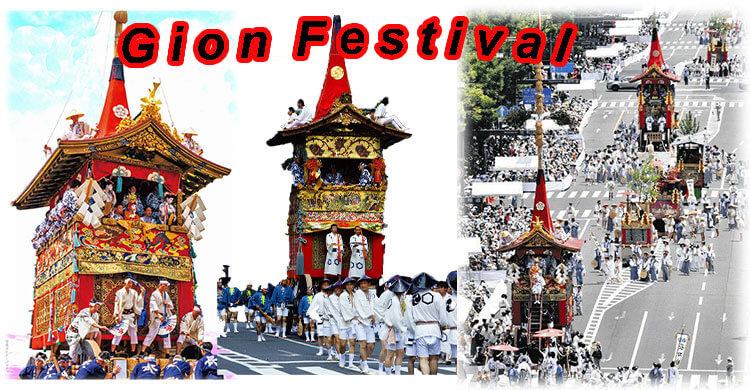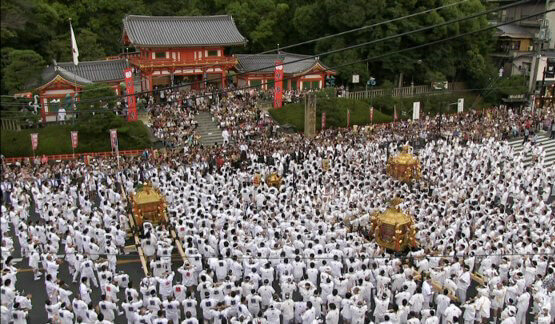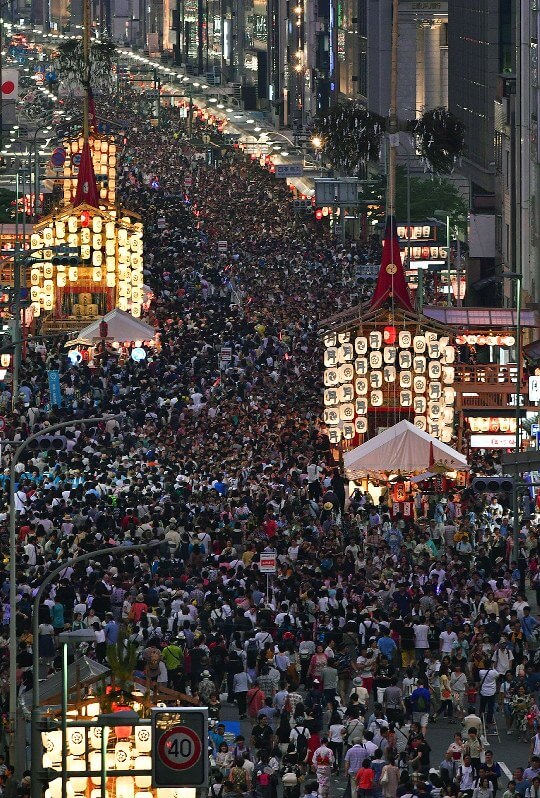Hi everyone how are you doing? Today’s topic is ”Gion Matsuri (Gion Festival)”, which is one of the Three Great Festivals of Kyoto and it’s typical “Cool Japan”.
In the historic city of Kyoto there are three famous festivals that have been celebrated for hundreds, even thousands of years.
Other two Festivals are Aoi (Hollyhock) Festival and Jidai Festival (Festival of Ages), and they are famous world-wide.

Aoi (Hollyhock) Festival on May 15

Jidai Festival (Festival of Ages) on Oct 22
Gion Matsuri (Festival) starts from July 1st to July 31st, spanning a whole month. So I’d like to talk about it today.
What’s Gion Matsuri (Festival)?
Every year in July, gorgeously decorated floats are paraded through the city of Kyoto as part of Gion Matsuri ( Gion Festival).
Around 1,100 years ago, outbreaks of plague occurred across the country. People believed the plague was caused by evil spirits, so they held a ceremony to appease them. This is thought to be the origin of Gion Mtsuri.
The festival’s floats are a means of carrying the deity of Yasaka Shrine (it used to be Gion Shrine and its name of the Shrine changed to Gion Shrine in the beginning of Meiji, 1868 by an Ordinance to distinguish Shinto and buddhism) around local neighbourhoods.
Today, 32 communities showcase their floats during the festival period, and the residents take great pride in them.
It’s actually a long festival, spanning a whole month. One of the early highlights is the assembly of the floats.
The people of each community spend about three days putting their float together. Remarkably, they do this using only straw ropes, without the use of nails.
The biggest floats weigh about 12 tons and are about 25 meters tall. Every float has a spear-like weapon, a pine tree, or some kind of sharp object attached to its topmost part, which is believed to serve as a magnet for the deity.
The decorations on the floats are another highlight of Gion Matsuri. Because they’re so beautifully adorned, the floats are sometimes called “museums on wheels”.
The decorations include many precious rugs and tapestries that were produced in countries such as China, Belgium, and Persia.
Gion Matsuri (Festival) had to be suspended for a while in the late 15th century due to the outbreak of a major war.
But it was later revived by wealthy townspeople, and the communities began to compete against one another to create the most impressive floats so as to flaunt their economic power.
Another highlight of the festival is called Yoiyama, which takes place on the eve of the grand parade of floats.
The floats are put on display, illuminated by paper lanterns. This gives them a different kind of appeal.
At the floats, you can buy a special kind of talisman called chimaki, which is believed to offer protection from illness.
And then comes the festival’s main event, Yamahoko Junko (Yamahoko means festival float mounted with a decorative balberd, Junko means a cruise), when the 32 floats are paraded down Kyoto’s main streets in a elegant manner. This is said to cleanse the area of impurities.
The moment when the giant floats have to be turned, which occurs at three points along the parade route, is a chance for the float-pullers to show their skills and really shine.
Gion Matsuri (Festival) is one of the high points of the summer in Kyoto, and it’s imbued with a strong sense of local pride, just as it always has been.
Finally, why don’t you head to Kyoto for the real thing, Have a good time there!
Besides this Gion Matsuri (Festival), we have other several Matsuri’s webpages that are very popular as follows,
Matsuri (Festival), Sanja Matsuri (Festival), Chichibu Night Festival, Aomori Nebuta Matsuri (festival), Let’s enjoy Aho(fool) dance at Awa Odori Festival!, and Mikoshi (Portable Shrine)














Leave a Comment